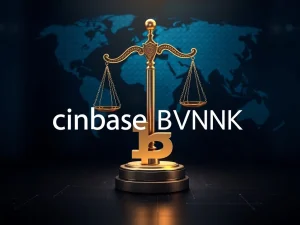Urgent: Why Stablecoins Are Surging Amid Depegging Fears and Regulatory Focus

Stablecoins are experiencing a significant resurgence, attracting major players from traditional finance. But as banks and payment giants enter the market, critical questions around stability, crypto regulation, fraud, and the core concept of decentralization are coming into sharp focus. Let’s dive into what’s driving this renewed interest and the challenges that lie ahead.
The Rise of Institutional Crypto and Stablecoins
Traditional financial institutions are increasingly exploring and adopting stablecoins. Firms like Bank of America and Standard Chartered are reportedly considering launching their own, following JPMorgan’s lead with JPM Coin (now Kinexys Digital Payments) for institutional transactions. Mastercard is working to integrate stablecoins directly into its global payment network, bypassing conversions. Visa recently joined the Global Dollar Network (USDG) stablecoin consortium, marking a significant traditional finance entry. Even NYSE parent Intercontinental Exchange (ICE) is investigating uses for USDC and US Yield Coin within its markets. This wave of institutional crypto adoption signals a potential shift in how stablecoins are perceived and used on a large scale.
Driving Forces: Regulatory Clarity and Acceptance
A key factor behind the renewed interest in stablecoins is evolving regulatory clarity. Both the United States and Europe are developing more defined guidelines. In the US, Congress is considering legislation specifically for stablecoins, aiming to establish formal standards. The EU’s Markets in Crypto-Assets (MiCA) regulation imposes strict financial and reserve requirements on stablecoin issuers. The UK is also planning consultations to draft specific rules. Furthermore, a US executive order explicitly supports the development and growth of legitimate dollar-backed stablecoins while prohibiting a US CBDC. This regulatory movement, coupled with initiatives like Trump’s World Liberty Financial launching a USD1 stablecoin, suggests a future where stablecoins, particularly USD-pegged ones, play a significant role, bolstered by clearer crypto regulation.
The Stablecoin Landscape: More Than Just Two Players?
While over 200 stablecoins exist, pegged mostly to the US dollar, the market is dominated by Tether (USDT) and USDC, holding 65% and 28% of the market cap respectively. Both are centralized and fiat-collateralized. A newer entrant, USDe, has quickly gained market share (around 2%), using a unique, derivative-based mechanism that incorporates centralized elements despite running on a DeFi protocol. Understanding the different mechanisms is crucial:
- **Centralized, Fiat-Collateralized:** Backed by reserves (currency, gold) held by a central entity. Tokens represent claims on the underlying asset. (e.g., USDT, USDC)
- **Decentralized, Cryptocurrency-Collateralized:** Backed by other decentralized crypto assets, often over-collateralized to manage volatility. (e.g., Dai)
- **Decentralized, Uncollateralized (Algorithmic):** Maintains stability by algorithmically controlling supply, similar in principle (but not credibility or legal tender status) to central banks.
Understanding Depegging Risk and the Threat of Fraudsters
Stablecoins are designed to maintain a stable value, overcoming the volatility of other cryptocurrencies. Stability relies on being pegged to a stable asset and having a robust mechanism to sustain that peg. USDe, for instance, uses delta hedging with derivatives (short and long futures positions) to maintain its USD peg, generating a high yield (27% annually compared to 12% for some others). However, reliance on derivatives introduces inherent risk, potentially running counter to the goal of stability.
While stablecoins have existed for over a decade, major depegging events have been rare, with the collapse of Terra being the most notable. The TerraUSD (UST) depegging wasn’t simply a mechanism failure; it involved alleged fraud and manipulation. UST used an algorithmic arbitrage mechanism with its sister coin, LUNA. The Anchor protocol offered an unsustainable 19.5% yield for staking UST, which analysis showed was operating at a loss well before the collapse. Allegations in lawsuits against Terraform Labs founders claim Anchor was a Ponzi scheme. Recent legal actions, including a $200 million settlement by Galaxy Digital over LUNA promotion and Do Kwon being found liable for securities fraud, highlight the legal fallout. If regulators aim to prevent future Terra-like fiascos, their focus should arguably be on deterring fraudsters and manipulators from issuing or engaging with stablecoins, addressing the human element behind the depegging risk.
Decentralization: A Core Conflict for Stablecoins?
Many prominent stablecoins are centralized and collateralized by assets held by a company. This structure raises concerns about potential misuse of funds or false claims about reserves, necessitating regulatory oversight akin to securities laws. This centralization runs counter to the original premise of Bitcoin and blockchain technology – a decentralized system free from intermediaries, banks, or governments.
While centralized stablecoins offer convenience and regulatory familiarity, they challenge the decentralized ethos of crypto. Decentralized stablecoins, like Dai, aim to capture this original vision. Perhaps the current era of stablecoin growth, driven by institutional interest and clearer crypto regulation, also presents an opportunity to rekindle the idea of a truly decentralized, algorithmic stablecoin – one free from centralized control, reviving the core principles of blockchain technology in a stable format.
Conclusion
The stablecoin market is expanding rapidly, fueled by institutional adoption and evolving regulatory frameworks. While offering a bridge between traditional finance and the crypto world, stablecoins face significant challenges. Addressing the depegging risk, combating fraud, and navigating the fundamental tension between centralization and decentralization will be critical for their long-term success and widespread acceptance. As the landscape matures, the debate between regulated, centralized stability and the promise of decentralized, trustless value transfer will continue to shape the future of digital currencies.







